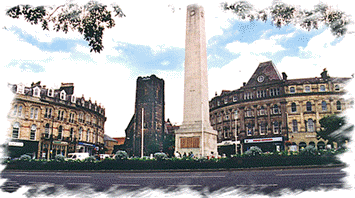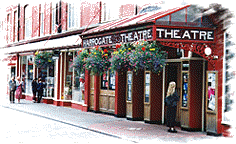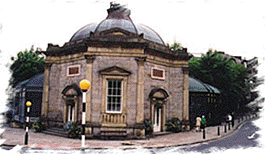Harrogate
Places, like people, have reputations. Images, in today’s marketing jargon. If Barnsley is your working-class mate, Leeds is your flash neighbour, nouveau riche in a big pretentious car. Filey is the girl next door, just home from boarding school in the 1950s. Bradford is your reliable old friend, honest, straightforward but a bit down on his luck. And Harrogate? Harrogate (pronounced Harrowgate) is the dignified maiden aunt or the dowager, old money, distantly related to royalty, a little prim, 1662 Prayer Book, don’t show emotion, that sort of thing. If Jennifer Paterson (the Fat Lady cook and preserver of no-nonsense values, God bless her) had lived in the North of England, she would have lived in Harrogate.
The Rough Guide to England describes Harrogate as ‘Yorkshire’s tea-shop capital’. James Herriot regarded it as his haven. ‘To Helen and me it is still the exhilarating leisure-place, the town on a hill, blown over constantly by the fresh Yorkshire wind’. In his books Brawton is Harrogate.
Harrogate owes its existence to its springs, its medicinal mineral waters. It is thought that these were known of in medieval times. Tewit Well was discovered in 1571 and then about eighty further springs were found. Patients and others came to benefit from the waters. It was in the early nineteenth century that Harrogate was developed as a spa town. The construction of the railways hastened its growth. Today two things are immediately striking about Harrogate - its open spaces and its wealth of Regency and Victorian buildings, some, like the large hotels, huge piles of elaborate and Gothic stone.
The Stray, in the centre of Harrogate, is a common of some 200 acres, bordered by trees and intersected by paths. How fortunate we all are that the Victorians gave and protected these places. There is nothing developers and councils would like more than to make money by building executive houses and shopping centres on such green spaces in our towns and cities. The Valley Gardens is a park in a more cultivated and landscaped sense. One can walk through it to Harlow Carr Botanical Gardens on the edge of the town. That is a mix of garden and semi-wilderness.
In the town centre are the Royal Baths and Assembly Rooms which have within them restored Turkish baths. The Royal Pump Room, now a museum, includes a restored old sulphur well. Spa water is available. Other Victorian buildings (ignore the occasional 1960s and 70s horrors) like the Royal Hall and the Opera House contribute to the atmosphere which reflects the pride and extravagance of the past and its faded glory today.
Nowadays Harrogate has established itself as a centre for conferences and shows. The Great Yorkshire Show, an agricultural event, takes place each July. There is a large Antiques Show in September. There are Flower Shows in both spring and autumn and various art festivals.
Betty’s is the queen of cafes or tea-shops. It stands at the top of Parliament Street overlooking Montpellier Gardens. What a fine name for the main thoroughfare - Parliament Street. Nowadays streets seem to be named after second-rate Labour councillors or sporting heroes.
Harrogate is fairly close to two of my favourite places - Brimham Rocks and Fountains Abbey, both, fortunately, owned by the National Trust. Brimham Rocks, above Nidderdale, is made up of outcrops of rock sculptured by the wind into a variety of fantastic shapes over millions of years. A Daily Telegraph publication described it wonderfully as ‘Emily Bronté meets Salvador Dali’. Spot on. Go there at dusk. Fountains Abbey, founded by Cistercian monks in 1132 and now a World Heritage Site, and Studley Royal, a landscape of water and gardens together with a deer park, cover 800 acres. It is heaven. Go there when the primroses are out. (I’m not quite sure who decides somewhere is to be a World Heritage Site but at least it probably means they won’t pull it down and build executive houses). Fountains Abbey has an award winning two million pound Visitors’ Centre built in 1992, if you like that sort of thing.
Betty's and Brimham Rocks (Click)
From Studley Royal Ripon Cathedral can be seen. It is relatively unknown despite having been founded in 672. When I visit our great cathedrals I often recall W.H. Auden’s description of them as ‘luxury liners laden with souls’.
Harrogate looks lovely in the early spring when the Stray is carpeted with crocuses. But I think I like Harrogate best in the run-up to Christmas. The trees are covered in coloured lights, not the meretricious multi-coloured lights that are everywhere, but rather each tree is festooned with lights of one colour. They know about style and class in Harrogate. The streets and shops are busy but not frantic or harassed like the cities. Of course in, for example, the bookshops there is not the range of Waterstone’s or Borders in Leeds but it is a civilised way to get prepared for the Christmas holidays and is far more enjoyable than struggling through the crowds. One can stop awhile in Betty’s or one of the old pubs or newer bars and bistros. One can sense Christmas past. Civilised. That’s the word.
David Brearley




